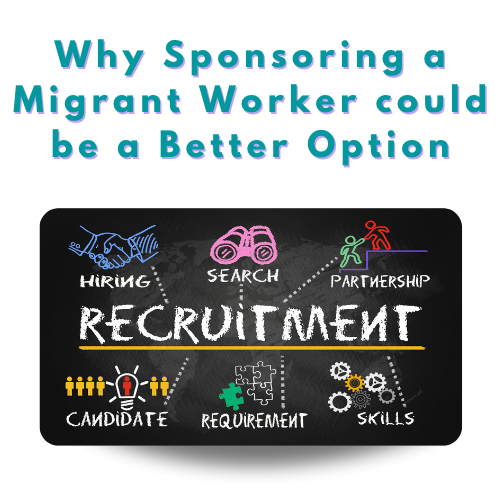
12 Feb The Rising Cost and Time of Hiring New Employees in Australia: Why Sponsoring a Migrant Worker could be a Better Option
The cost-effectiveness of sponsoring a migrant worker is also reflected in the growing popularity of this option among businesses in Australia. According to the Department of Home Affairs, in the 2021-2022 financial year, there were over 32,062 approved employer-sponsored 482 TSS visas in Australia, a significant increase of 38.4% from the previous year, 29,365 approved visa applications for 491 skilled regional (provisional) visa from December 2019 to October 2022. This trend highlights the growing popularity of sponsoring migrant workers as a solution to the rising cost and time of hiring new employees. The 482 Visa is called the Temporary Skill Shortage visa and processing times in 2023 are much more practical than they have been in previous years.
However, it’s important to note that there are also potential disadvantages to consider, such as the complexity of the visa process, language and cultural barriers, and the need to comply with immigration laws and regulations. Businesses should carefully consider their needs, resources, and goals when deciding whether to hire a migrant worker or a local employee.
Pros and Cons of Hiring Migrant Workers
Pros of Hiring Migrant Workers:
- Lower costs: The cost of obtaining a visa and sponsoring a migrant worker is usually lower than the cost of hiring a local employee, taking into account recruitment and selection costs, onboarding and training, and wage costs. Being able to have a worker locked in the role for 2-4 years (depending on the visa class) will allow the business to lower recruitment and training-related costs.
- Access to a larger pool of skilled workers: Sponsoring a migrant worker provides businesses with access to a larger pool of skilled workers, including those from overseas, reducing the pressure on the local workforce.
- Lower wage costs: Many migrant workers are willing to accept lower salaries than local workers, which can help businesses to reduce their overall labour costs.
Cons of Hiring Migrant Workers:
- Complex visa process: The visa process can be complex and time-consuming, requiring businesses to comply with immigration laws and regulations.
- Language and cultural barriers: Migrant workers may have difficulty adapting to the local language and culture, which can create communication difficulties and slow down the onboarding and training process.
- Compliance with immigration laws: Businesses must comply with immigration laws and regulations when sponsoring a migrant worker, which can increase the risk of non-compliance and result in costly fines and penalties.
In conclusion, the cost and time associated with hiring new employees in Australia have increased significantly in recent years, making it a challenge for businesses to attract and retain the best talent. One solution that has emerged as a cost-effective alternative to hiring local employees is the sponsorship of migrant workers. With the ability to reduce recruitment and training costs, lower wage costs, and provide access to a larger pool of skilled workers, sponsoring a migrant worker is a great option for businesses looking to expand and grow. With the growing popularity of this option, it is clear that many businesses in Australia are recognizing the benefits of hiring migrant workers and the cost-effectiveness that this option provides.
If you are an Australian business owner or a skilled migrant worker, who wants to explore more about employer-sponsored visas, give us a call and our principal migration agent Evan Bishop MARN 1679414 of Worldly Migration will be happy to provide more in-depth information and guidance on your visa options.



No Comments